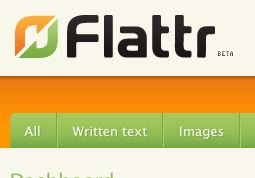Flattr Opens Floodgates, Drops “Give to Get” Requirement
 As many of you may recall, last summer I tried an experiment with the social payment system Flattr. After a 30 day run with the service, I posted a review of Flattr’s service.
As many of you may recall, last summer I tried an experiment with the social payment system Flattr. After a 30 day run with the service, I posted a review of Flattr’s service.
Flattr is a service that works very similarly to Twitter or Facebook buttons in that they encourage users to “like” or, in this case, “Flattr” content. However, unlike those services, which simply share the content on those social networks, Flattr users are giving money to webmasters and content creators.
To do this, users put money into a Flattr account and then, with every click of a Flattr button, they give a portion of that money to the content owner. The more content they “Flattr” the more the money is divided up.
In my attempt to see if Flattr was a good business model for Plagiarism Today and sites like it, I managed to lose money, albeit a small amount, struggled with speed and reliability issues with the button and failed to find a lot of good content to Flattr myself.
However, last week Flattr announced a change to its service that will alleviate at least one of those problems. Saying that it is “Opening the Floodgates” Flattr is dropping the requirement to add money in your account to be able to have others Flattr your work. In short, you can now add a Flattr button to your site and receive money without first spending money.
Flattr hopes that this will attract new people to its service, will encourage others to put the Flattr button on their sites, making more content Flattr-able, and generally increase usage of the service. The company also said that it doesn’t feel the need to force users to put money into their accounts because, based on what they are seeing, there’s no need to force people to give.
Unfortunately, it remains to be seen how big of an impact this move will have. Though Flattr does boast some impressive numbers, including 175,000 items receiving some 500,000 Flattrs, the penetration of the service in the U.S. seems to be rather weak and I struggled both to receive Flattrs and find other content to Flattr. Also, it remains to be seen if the technical issues with the button have been resolved, the biggest back then was slow loading times.
Still, this may call for revisiting the service in the near future and, if there is enough interest, I may conduct another 30-day experiment shortly.
In the meantime, this is an interesting move for Flattr that may make it more accessible to users who, otherwise, would never have been able to take advantage of it.
Want to Reuse or Republish this Content?
If you want to feature this article in your site, classroom or elsewhere, just let us know! We usually grant permission within 24 hours.
